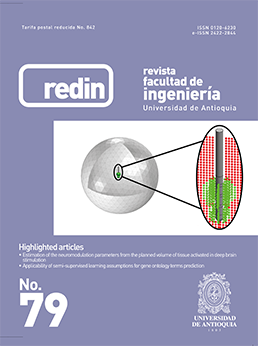Impact of the error sensing probability in wide coverage areas of clustered-based wireless sensor networks
DOI:
https://doi.org/10.17533/udea.redin.n79a07Keywords:
clustering, adaptive transmission, Markov chain, wide area wireless sensor networkAbstract
Wireless sensor networks are composed by a big number of autonomous nodes surveying a certain environmental parameter, such as temperature, humidity or even mobile targets. In this work, we focus on mobile target detection in wide area systems such as tracking animals in a forest or vehicle detection in security missions. Specifically, a low energy consumption clustering protocol is proposed, analyzed and studied. To this end, two communication schemes, based on the well-known LEACH protocol are proposed. The performance of the system is studied by means of a mathematical model that describes the behavior of the network under the most relevant parameters such as coverage radius, transmission radius, and number of nodes inside the network. Additionally, the transmission probability in the cluster formation phase is studied under realistic considerations of a wireless channel, where signal detection errors occur due to interference and noise in the access channel.
Downloads
References
H. Lee, “Towards a general wireless sensor network platform for outdoor environment monitoring”, in IEEE Sensors Conference, Taipei, China, 2012, pp. 1-5.
National Instruments Corporation, ¿Qué es una Red de Sensores Inalámbricos?, 2009. [Online]. Available: http://www.ni.com/white-paper/7142/es/. Accessed on: Dec. 15, 2013.
J. Querol, Estudio y evaluación de prestaciones de redes inalámbricas de sensores, 2011. [Online]. Available: https://riunet.upv.es/bitstream/handle/10251/10354/Proyecto_Querol.pdf. Accessed on: Nov. 07, 2013.
P. Mohapatra and K. Kredo, “Medium access control in wireless sensor networks”, Computer Networks, vol. 51, no. 4, pp. 961-994, 2007.
M. Handy, M. Haase and D. Timmermann, “Low energy adaptive clustering hierarchy with deterministic cluster-head selection”, in 4th International Workshop onMobile and Wireless Communications Network, Stockholm, Sweden, 2002, pp. 368-372.
M. Ramírez, M. Rivero and I. Villordo, “Monitoreo de tráfico vehicular en sistemas V2I mediante el uso de una red inalámbrica de sensores”,Rev. Fac. Ing. Univ. Ant., no. 71, pp. 115-125, 2014.
M. Rivero and I. Orea, “Tools for the selection of the transmission probability in the cluster formation phase for Event-Driven Wireless Sensor Networks”, Rev. Fac. Ing. Univ. Ant., no. 73, pp. 101-110, 2014.
D. Johnson and D. Maltz, “Truly seamless wireless and mobile host networking. Protocols for adaptive wireless and mobile networking”, IEEE Personal Communications, vol. 3, no. 1, pp. 34-42,1996.
R. Rom and M. Sidi, Multiple access protocols. Performance and analysis. New York, USA: SpringerVerlag, 1990.
W. Heinzelman, A. Chandrakasan and H. Balakrishnan, “Energy-efficient communication protocol for wireless microsensor networks”, in 33rd Annual Hawaii International Conference on System Sciences, Maui, USA, 2000.
S. Chaurasiya, J. Sen, S. Chaterjee and S. Bit, “An energy-balanced lifetime enhancing clustering for WSN (EBLEC)”, in 14th International Conference on Advanced Communication Technology (ICACT),PyeongChang, South Korea, 2012, pp. 189-194.
A. Mehmood, S. Khan, B. Shams and J. Lloret, “Energy-efficient multi-level and distance-aware clustering mechanism for WSNs”, International Journal of Communication Systems, vol. 28, no. 5, pp. 972-989, 2015.
A. Varga, “The OMNeT++ discrete event simulation system”, in European Simulation Multiconference (ESM), 2001, pp. 65-71.
I. Leyva, “Diseño y análisis de desempeño de un protocolo de acceso aleatorio para redes inalámbricas de sensores por eventos”, Undergraduate thesis (unpublished), Instituto Politécnico Nacional, México City, México, 2011.
M. Ramírez, “Análisis del desempeño de una red Ad-Hoc vehicular para sistemas de información móvil”, Undergraduate thesis (unpublished), Instituto Politécnico Nacional, México City, México, 2012.
M. Rivero, G. Rubino, I. Torres and L. Martinez, “Windowbased streaming Video-on-Demand transmission on BitTorrent-like Peer-to-Peer networks”, in IEEE Consumer Communications and Networking Conference (CCNC), Las Vegas, USA, 2013, pp. 1-6.
M. Ismail, M.Shanudin and R. Saqour, “Discrete-event simulation modeling tool for routing process in GPSR ad hoc network routing protocol”, in IEEE International Conference on Telecommunications and Malaysia International Conference on Communications (ICTMICC), Penang, Malaysia, 2007, pp. 86-90.
Downloads
Published
How to Cite
Issue
Section
License
Copyright (c) 2016 Revista Facultad de Ingeniería Universidad de Antioquia

This work is licensed under a Creative Commons Attribution-NonCommercial-ShareAlike 4.0 International License.
Revista Facultad de Ingeniería, Universidad de Antioquia is licensed under the Creative Commons Attribution BY-NC-SA 4.0 license. https://creativecommons.org/licenses/by-nc-sa/4.0/deed.en
You are free to:
Share — copy and redistribute the material in any medium or format
Adapt — remix, transform, and build upon the material
Under the following terms:
Attribution — You must give appropriate credit, provide a link to the license, and indicate if changes were made. You may do so in any reasonable manner, but not in any way that suggests the licensor endorses you or your use.
NonCommercial — You may not use the material for commercial purposes.
ShareAlike — If you remix, transform, or build upon the material, you must distribute your contributions under the same license as the original.
The material published in the journal can be distributed, copied and exhibited by third parties if the respective credits are given to the journal. No commercial benefit can be obtained and derivative works must be under the same license terms as the original work.










 Twitter
Twitter